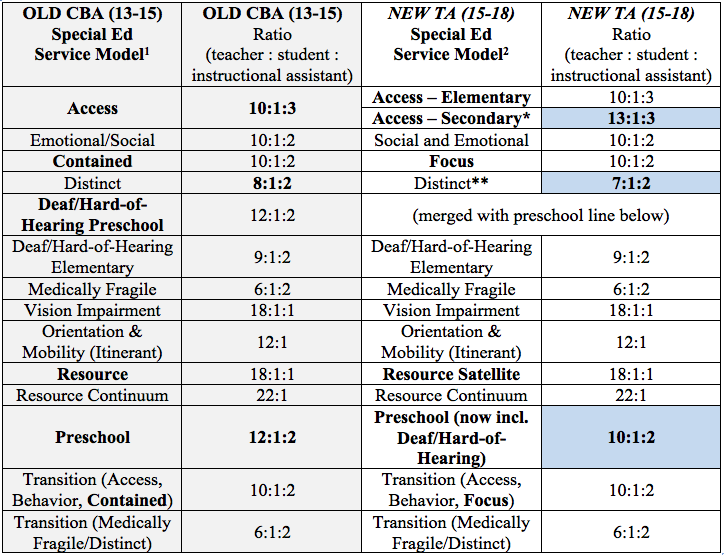Proposed Staff Ratios in New Teachers Contract
From SPS via KPLU (here's link to complete page with footnotes):
Just noticed this tweet to KPLU:
Ratio definition is flipped. Should be (student:teacher:IA), but says (teacher:student:IA).
From SEA page - complete overview of contract.
 | ||
Ratio definition is flipped. Should be (student:teacher:IA), but says (teacher:student:IA).
From SEA page - complete overview of contract.
Comments

Service Model

Proposed

Access

10:1:3
Emotional/Social
10:1:2
Contained
10:1:2
Distinct
8:1:2
Deaf/Hard of Hearing Preschool
12:1:2
Deaf/Hard Hearing Elem.
9:1:2
Med Fragile
6:1:2
Vision Impairment
12:1:1
Orientation & Mobility (Itinerant)
12:1
Resource
18:1:1
Resource Continuum
22:1
Preschool
12:1:2
Transition (Access, Behavior, Contained)
10:1:2
Transition (Med Frag/Distinct)
6:1:2
88
double check
sss.westbrook@gmail.com
What's the message here? You can have the staffing you need - but only if you're willing to swallow segregation and sit in the patty-cake room all day. Same old, same old. And it never saves a dime. It just means that more and more students will have to be in self-contained settings, and that will make them more expensive.
The other thing about having tiny ratio's like 7:1:2 or 6:1:2.... when those programs aren't full, they're still FULLY staffed. So it's often 3:1:2, or 4:1:2. Because you can't kill a program if somebody's still in it. Sometimes there are even more staff than students.
Vote no.
Sped Reader
Voting no
I agree SPED didn't get much of anything in this contract. In fact, in some areas it is even worse. I think OSPI should take SPS to the cleaners and then maybe they would put some more money and resources into actual staff working with kids instead of supervisors/compliance people. Having more compliance people doesn't get you into compliance. Putting money into staffing and services gets you into compliance, or at least closer. I don't think voting no on the contract is going to solve the SPED issues. If I did, I would vote for it.
Teacher
Sped Reader
Teacher
Sped Reader
I am voting yes.
I agree SPED didn't get much of anything in this contract. In fact, in some areas it is even worse.
This is depressing. I don't have a kid in SpEd, but the way I've been reading the SpEd-related conversations it sounds like most teachers don't see SpEd as their problem, so they'll vote for the TA and leave it to someone else to fix SpEd. Even if nobody will.
Am I off base?
HF
Teacher
Both Wyeth Jesse (Special Education Director) and Phyllis Campano (SEA Vice President) have stated repeatedly to special education teachers that these newly approved ratios for the recently ratified teachers contract will NOT be implemented until the 2016-17 school year.
This adversely affects all students in special education programs because they are not receiving the agreed upon number of student to staff ratios, and as such many students have not been able to access the general education environment.